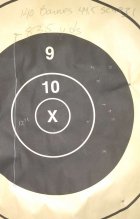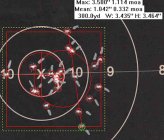@JimSC in the name of the topic of this thread, which was drilling down on velocity flat spots, what was your update on your load when taken out to distance?
The group shots where you showed <0.5 MOA but with poor ES, did those give a good group or vertical at distance? Did your scores go up or down in proportion to distance, not counting missed wind calls? Did you still see the "WTF flyers"?
Some nodes are tolerant of a bigger SD and some are not. For example, if the node is compensating in our favor, a fast shot comes in below a slow one. Depending on your luck, that effect balances with the velocity stat and the performance is still good at longer distances. But, the opposite is also true, meaning if the node we selected creates a proportional vertical spread at distance, then we either correct the root cause of the velocity spread or move to a different harmonic.
It is only my own opinion based on participating in not just small arms, but heavy weapons and artillery that it is better to know all the characteristics (Velocity and Groups) than it is to just know the groups (trajectory).
I can easily say that many folks who don't even own a chronograph are capable of shooting high performance groups at any distance, but then it is also my opinion that they learned to do so at greater shot counts than those who set out with both group and velocity in mind from the beginning when the context is greater than 600 yards. The whole point of Mike's thread is really about how much emphasis and resource should be put on the velocity and getting the overall tune with the fewest shots wasted.
ETA: It is also my opinion, that unless you already know the territory from a similar barrel and chamber, it isn't enough to just know the velocity stats cause those don't expose the group harmonics. Can you just shoot the groups, yes, but if you only test at short range you run the risk of finding out you needed a different node due to the velocity stats at that group node hiding the vertical issue you only uncover at range.












